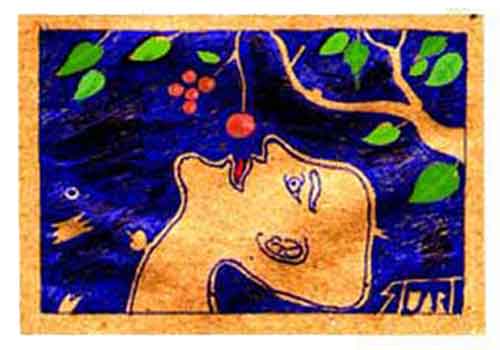
The Story Behind the Philippine Medicinal Plant Compilation |
||||||||||
Godofredo U. Stuart Jr. MD |
||||||||||
A Plantologist's Odyssey |
||||||||||
What remained was the beginnings of the Liceo Pulang Lupa project, the school that never came to be. But I continued to build. . . and build . . and build, and haven't stopped. In those early years, I was slowly being drawn to the idea of returning for good, rather than the earlier intention of dividing my time between the Philippines and a medical practice in Baltimore. The lingering memories of childhood spent in Tiaong—my birthplace, the familiar culture, the new possibilities and challenges that teased nudged me to return. The visits became re-immersions into the rural culture, the world of the boondock poor, rife with creatures of folklore (the capre, white ladies, duwendes, tikbalangs, and the nuno-sa-punso), teeming with superstitions, rich in rituals, celebrations, and alternative healing ways.
Although versed in western medicine, I have long been attuned to alternative and complementary medicine. Tiaong provided a window into the fascinating world of Philippine alternative medicine, rich in lore and religiosity, and malady-causing mythological creatures. The town became a school and I the avid student, extracting countless stories from the rural folk so willing to share their stories, so steeped in religiosity and superstitions, observing the healing ways of albularyos, hilots and medicos, the fringe modalities of anting-antings, orasyons and bulongs, and listening to the hand-me-down trove of traditional of medicinal plants for day-to-day maladies. My daily hikes from down the village to the construction site at the peak was a primer on a flora of mostly unfamiliar trees, plants, and flowers—my guide calling out some names, even folkloric medicinal uses of a few, but mostly, he called them damo (weed), puno (tree), or halaman (plant). Around that time, I read of Dr. Flavier's TAMA endorsement of 10 Philippine medicinal plants: akapulko, ampalaya, bawang, bayabas, lagundi, niyog-niyogan, pansit-pansitan, sambong, tsaang-gubat, and yerba-buena. It jump-started my interest in medicinal plants and immersion into Philippine alternative medicine. When I returned to Baltimore, I set up the StuartXchange website, which started with pages on alternative medicine with that short list of medicinal plants. Early on, as the compilation trudged along, new plant additions were few and far in-between. Then I came upon Dr Eduardo Quisumbing's Medicinal Plants of the Philippines, which provided information on botany, folkloric uses, and a modicum of basic phytoconstituents. Shortly after, I stumbled on Dr Domingo Madulid's Pictorial Cyclopedia of Philippine Ornamental Plants. (Sources) While neither contained scientific studies, Quisumbing's was a rich trove of vernacular and scientific names while Madulid's provided a wealth of images, both so helpful to the search for scientific and medicinal studies. As the list grew, I kept resetting goals—50 to 100 to 300 to 500 to 700 to . . . I was repeatedly advised: "Enough." But as the list grew, so did the emails of appreciation from students, researchers, teachers, doctors, healers. alternativists, plant lovers, weekend gardeners, herbal entrepreneurs, and even chefs, delighted by the edibility information. As the list grew, so did my obsession—spending four to eight hours a day, sifting through the web for botanical information and scientific studies, searching and photographing vines, flowers,,weeds, leaves and trees, hiking through forests and scaling hills, knocking on doors and intruding on gardens, pulling over whenever and wherever an unfamiliar tree or flower beckons. . . every new find always a "eureka" moment. And there have been thousands of other eureka moments that came while updating the plants pages for scientific studies, frequent moments of wonderment as so many plants are revealed to have a boggling spectrum of biologic activities: antioxidant, antiulcer, anticancer, antidiabetic, antiviral, anti-dengue, antimalarial, antibacterial, anti-almost-anything-and-everything. Searching through and extracting from tens of thousands of abstracts and PDFs have revealed a plant world of unbelievable potential to provide for many of the preventive and healing needs of humankind. Alas, in this age of big pharma and the commerce of healthcare, pharmaceuticals and white-coat medicine win, hands down, over medicinal plants.
When I returned in 2003—for good—after pulling out stakes in Baltimore, I wanted to devote part of my time to teaching clinical medicine; perhaps, even a course that would merge western medicine with Philippine alternative medicine. That too did not happen—I stayed with the plants, and, perhaps, for the best. The emails, web use and attributions suggest the plant materia medica is more far-reaching and a more lasting way of teaching, albeit, hermitic and faceless. While I continued to practice medicine, pro bono, occasionally paid with a chicken, eggs, or fruits, the accumulating knowledge on medicinal plants provided a serendipitous opportunity to merge western medicine and pharmaceutical therapies with medicinal plants, supplements, and local healing modalities. Alas, eureka moments and letters that delight have been tempered by discrepant observations. Of the more than 1,500 medicinal plants in the compilation, so few of the tens of thousands of studies were done in the Philippines. Institutional medicine has a continuing and unflagging disdain and distrust for alternative medicine. Uncommon is the physician who would give medicinal plants or traditional medicine the time of day. Invariably it comes from ignorance rather than educated opinion. Even in the rural areas, there is diminishing interest in medicinal plant use and alternative healing modalities. The albularyos are a disappearing breed of healers. Among the medicos, I have seen an increasing use of pharmaceuticals, steroids, antibiotics, and crude acupuncture. Even among the rural folk with their potpouri of hand-me-down therapies, there has been a shift toward the unprescribed use of pharmaceuticals. In the Philippines, the Barangay Health Care System is underutilized and misused. The barangay health care workers, potentially godsend for the dissemination of herbal medicinal therapies and alternative modalities, are woefully relegated to blood pressure monitoring and dispensing whatever medications are available for mundane complaints like headaches, fever, diarrhea, and pain. When I ask about teaching on how to make plant decoctions and infusions, the ready answer: We don't know what to teach, how to teach, and what we are allowed to teach. But while alternative medicine and plant use flounders in the rural areas, herbal medicinal plants thrive well in the commerce of supplements that lure customers with radio and TV adverts laced with come-on words like antioxidant, pure, holistic, rejuvenating, 100% natural, energy or immune boosting—some as slimiy as snake oil. Alas, my medicinal plant compilation has been used in the commerce of herbal supplements, luring customers with promises of health, cure and longevity. The most egregious, a
Fast Forward 2023 While some say "enough", I parry with "why not more?" There are hundreds—perhaps, a thousand or more—of nameless trees, shrubs and flowers waiting to be discovered, many of which I am certain will prove to have medicinal value. And there are many more in the dustbin of unstudied and understudied plants, stagnating in anonymity and academic neglect, waiting to be unearthed, rooted out, re-studied, and revealed of their medicinal benefits. Some concerned site users and herbalists who visit Pulang Lupa have asked if the compilation and site could just suddenly disappear from the internet. Also, some ask—what will happen to the compilation when I am gone (I hope that is still in some distant future). I have been told, warned, it will likely come to a dead end, or, perhaps, at best, it will survive as a stagnant out-dated reference volume of Philippine medicinal plants. While I ponder that often enough, I remain hopeful there will be kindred spirits who will find the work a worthwhile endeavor to continue. There are the occasional letters thankful for the medicinal plant compilation, who believe that it provides the essential springboard of information for when the pharmaceuticals of Big Pharma will be eschewed, when various traditional systems of medicine—Ayurvedic medicine, TCM (traditional Chinese medicine), Sindh, Kampo medicine (Japanese), Tibetan, African and South American—conglomerates into a renaissance of herbal medicinal use, and merge with the incredible science of western medicine. About 80% of the total population from developing countries use plants for medicinal purposes. Many prescription pharmaceuticals and over-the-counter medicines are plant based. Many plant studies on leaves, roots, bark, and flowers have suggested antioxidant, antidiabetic, antihyperlipidemic, antimicrobial, anticancer, analgesic properties, some comparable to or exceeding prescription medicines, and, of course, without the toxicities of pharmaceuticals. Philippine medicinal plants, along with the unique treatment modalities of Philippine alternative medicine, should be part of the medical school curriculum, to achieve, in the end, a softening of the chronic disdain that the medical establishment holds for herbal therapies and traditional medicine. That is another dream. But for now, let me go back to work. Plants are waiting. |
||||||||||
• |
||||||||||
Updated September 2025 / July 2025 / Sept 2023 / Aug 2021
May 2021
![]()
| List of Understudied Philippine Medicinal Plants |

 This compilation on Philippine medicinal plants is an accident. It started with no noble intention. Perhaps, the noble intention—the dream —was to build a small school house at the peak of family land in Tiaong, Quezon. We were to call it:
This compilation on Philippine medicinal plants is an accident. It started with no noble intention. Perhaps, the noble intention—the dream —was to build a small school house at the peak of family land in Tiaong, Quezon. We were to call it: